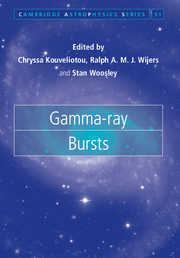Book contents
- Frontmatter
- Contents
- List of contributors
- Prologue
- 1 The discovery of the gamma-ray burst phenomenon
- 2 Instrumental principles
- 3 The BATSE era
- 4 The cosmological era
- 5 The Swift era
- 6 Discoveries enabled by multiwavelength afterglow observations of gamma-ray bursts
- 7 Prompt emission from gamma-ray bursts
- 8 Basic gamma-ray burst afterglows
- 9 The GRB–supernova connection
- 10 Models for gamma-ray burst progenitors and central engines
- 11 Jets and gamma-ray burst unification schemes
- 12 High-energy cosmic rays and neutrinos
- 13 Long gamma-ray burst host galaxies and their environments
- 14 Gamma-ray burst cosmology
- 15 Epilogue
- Indix
- Plate section
- References
2 - Instrumental principles
Published online by Cambridge University Press: 05 December 2012
- Frontmatter
- Contents
- List of contributors
- Prologue
- 1 The discovery of the gamma-ray burst phenomenon
- 2 Instrumental principles
- 3 The BATSE era
- 4 The cosmological era
- 5 The Swift era
- 6 Discoveries enabled by multiwavelength afterglow observations of gamma-ray bursts
- 7 Prompt emission from gamma-ray bursts
- 8 Basic gamma-ray burst afterglows
- 9 The GRB–supernova connection
- 10 Models for gamma-ray burst progenitors and central engines
- 11 Jets and gamma-ray burst unification schemes
- 12 High-energy cosmic rays and neutrinos
- 13 Long gamma-ray burst host galaxies and their environments
- 14 Gamma-ray burst cosmology
- 15 Epilogue
- Indix
- Plate section
- References
Summary
The first gamma-ray burst instrumentation
In the mid-sixties the Universe was thought to be quite bland, so the first instruments that detected gamma-ray bursts (GRBs) were intended for a very different application. Through fortuitous similarity with the techniques needed to detect nuclear explosions, the Vela satellites had the ability to recognize that a GRB is occurring, provide enhanced telemetry for the burst, and locate it (Chapter 1; Klebesadel et al. 1973). These characteristics have been necessary for virtually all subsequent GRB instrumentation. Instrumentation for all other high-energy astrophysics applications know what direction to look and when. The randomness of GRBs in space and time requires specialized adaptations of the standard gamma-ray detectors used on the ground (scintillators, proportional counters, solid state detectors, charge-coupled devices (CCDs)). In the following sections, we will discuss the principles and strategies used in GRB instrumentation in four areas that dominate a design: spectral techniques, temporal techniques, determining a direction to the burst, and networks of multiple-wavelength sensors.
Spectral techniques
The early workhorses of GRB instrumentation were gamma-ray scintillators such as NaI and CsI used in, for example, the Konus experiments (Mazets et al. 1981), the Pioneer Venus Orbiter (PVO; Klebesadel et al. 1980), the International Sun–Earth Explorer (ISEE-3; Anderson et al. 1978), the French-Soviet Venera satellites (Barat et al. 1981) and the Solar Maximum Mission (SMM; Forest et al. 1980). Hurley (1984) has a detailed review of the early instrumentation. Gamma rays interact within a crystal, producing an optical signal that is processed by a photomultiplier.
- Type
- Chapter
- Information
- Gamma-ray Bursts , pp. 9 - 18Publisher: Cambridge University PressPrint publication year: 2012



